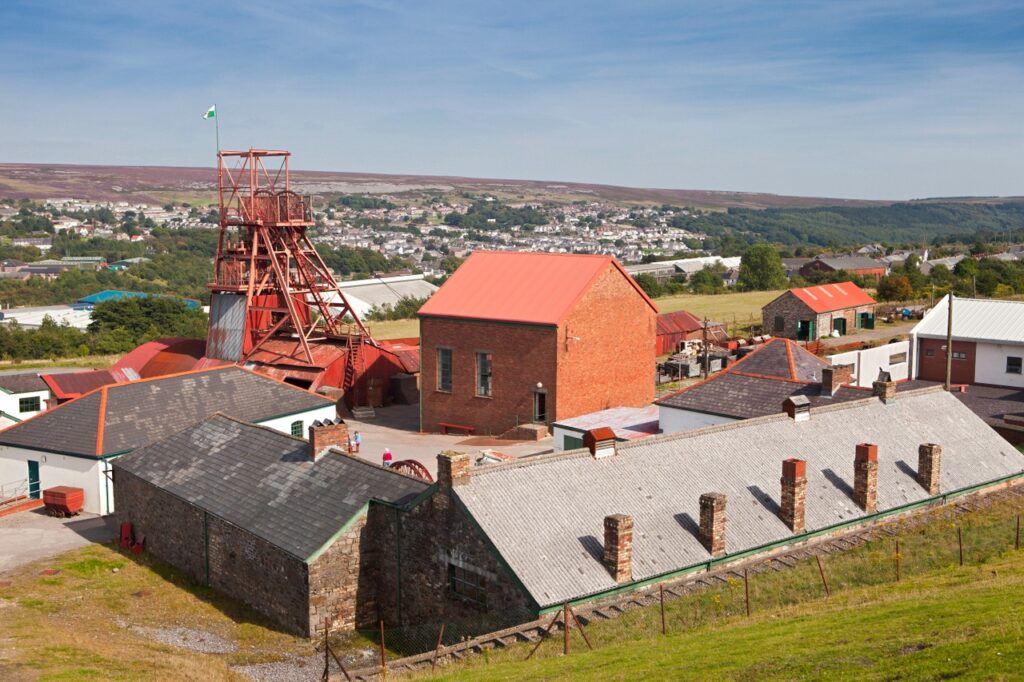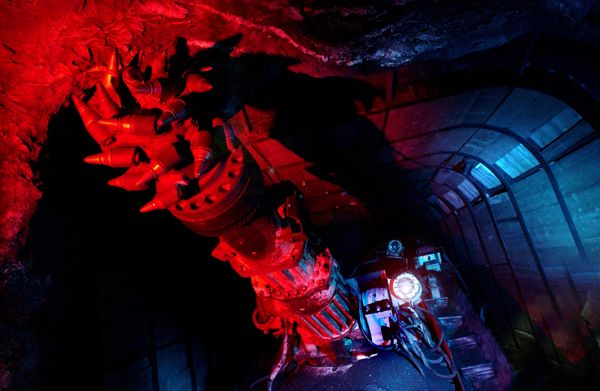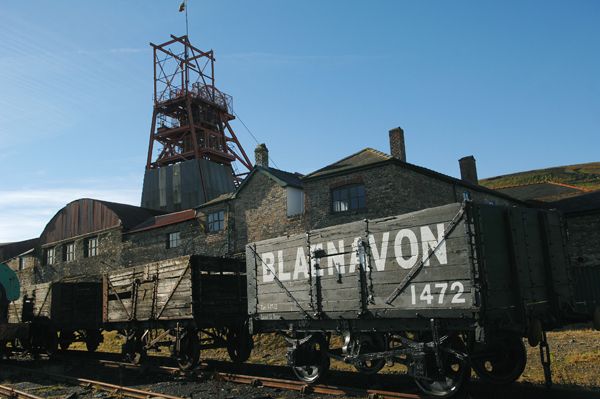Big Pit National Coal Museum

SET in the unique Blaenavon Industrial Landscape and designated a UNESCO World Heritage Site, Big Pit is a real coal mine and one of Britain’s leading mining museums, offering visitors a real underground experience.
With facilities to educate and entertain all ages, Big Pit is an exciting and informative day out. Enjoy a multi-media tour of a modern coal mine with a virtual miner in the Mining Galleries, exhibitions in the Pithead Baths and Historic colliery buildings.
All this AND the world-famous Underground Tour. Go 300 feet underground with a real miner and see what life was like for the thousands of men who worked at the coal face.
An award-winning national museum that still retains many features of its former life as a coal mine, standing high on the heather-clad moors of Blaenavon, Torfaen, the tunnels and buildings that once echoed to the sound of the miners now enjoy the sound of the footsteps and chatter of visitors from all over the world.
THE UNDERGROUND TOUR
Prepare to be lowered 90 metres (300 feet) down the Big Pit mineshaft for our famous underground tour – a captivating journey around a section of original underground workings.
Visitors wear the very same equipment – helmet, cap lamp, belt, battery and ‘self rescuer’ – used by miners. Take a seat in the miners Waiting Rooms before embarking on your journey.
The attached offices were used by the colliery manager and his senior staff. Most are still used for their original purposes, with the timekeeper’s office restored and the officials’ lodge converted into a first aid room.
The area around the top of the shaft, or the ‘pit bank’ as it is usually known, was always a noisy, busy place with men and materials descending the mine and drams of coal brought to the surface. It remains so today, with visitors setting off for and returning from their underground tours.
The Tram Circuit nearby is the route taken by the filled drams. Raised to the surface by cage, they ran along the rails and were turned upside down, emptying the coal on to screening belts to be graded into various sizes according to market requirements.
The modern Lamp Room is a working area, used to maintain and charge the electric cap lamps used by both visitors and staff. The Big Pit lamp man and his staff also look after that most easily recognised symbol of the coal industry – the flame safety lamp.
Today carried only by colliery officials as gas detectors, these lamps were once the miner’s only source of light.

Once underground, you will be guided (a 50-minute walk) around the coal faces, engine houses and stables in the company of a former coal miner.
Your guide will explain the different ways in which coal was mined and transported, and share some of his own experiences.
MINING GALLERIES
Enjoy an exciting audio-visual experience with exhibitions of modern mining equipment in the Big Pit Mining Galleries.
Set into the hillside above the colliery, the galleries house simulated underground workings and a multi-media presentation telling the story of how the Welsh mining industry evolved.
From the collier craftsmen into the sophisticated, mechanised modern industry of today, the story begins with a short film followed by three display areas. See how miners reach the coal by using explosives or large rock cutting machines.
View a reconstructed ‘Power loading’ coal face of the 1970s with armoured conveyors, hydraulic roof supports and a cutter/loader, which cuts the coal by means of tungsten tipped picks attached to a revolving drum.

There is also an earlier type of coal face (1950s/1960s) with an undercutting machine – a huge chainsaw. After the coal was cut it was filled onto a conveyor belt by hand, while the roof is held up by the traditional wooden posts or ‘pit props’.
PITHEAD BATHS
The Pithead Baths building houses four exhibition spaces and uses objects and images to tell the story of coal mining in Wales.
Themes include children in the mines, health, home life and the mining communities. See how the life and work of a miner has changed from 1850 to 2000.
Learn about the geology and uses of coal, mining disasters and rescue, discover the role and impact of trade unions and nationalisation, and get a closer look at some mining memorabilia.
Walking through the pithead baths today, it’s difficult to imagine the great impact these buildings had on the lives of the miner and his family.
Prior to the introduction of baths, miners had no option but to travel home dirty and wash in a tin bath, in front of the fire or outside in the ‘bailey’ (back yard).
Each miner had a ‘clean’ locker and a ‘dirty’ locker located in different parts of the baths. Leaving his ordinary clothes in the clean locker, the miner changed into his working clothes ready for his shift underground.
Afterwards the miner left his work clothes in the dirty locker where it would be dried, ready for his next shift, by hot air constantly blowing through the lockers.

There is also a multifunction space serving as an education room, packed lunch room and lecture theatre, housing both temporary and permanent exhibitions. The permanent exhibition deals with the controversial subject of energy sustainability.
Big Pit’s Medical Centre is located next to the Pithead Baths and canteen. After nationalisation in 1947, health and safety procedures improved and proper medical centres were built and attendants appointed.
Most of their hours were spent treating the day-to-day cuts, bruises and strains that miners had suffered. However, at times the attendants had to care for miners who had been seriously injured underground. The voice that you can hear in the medical centre is that of Mrs Phyllis Jones, a former colliery nurse in Cynheidre Colliery.
HISTORIC BUILDINGS
You can see and interact with various buildings and machinery around the museum site that would have been crucial to the mining operations at Big Pit.
The Winding Engine house or ‘the winder’, as it is known, raises and lowers the cages carrying coal, men and materials up and down the shaft.
Though the engine is over 50 years-old, it has been fully modernised with safety systems and computers controlling and monitoring its operation.
The buildings around The Blacksmiths’ Yard are some of the oldest on site, dating from the 1870s. The left-hand wing is the fitting and welding shop which is still used by Big Pit’s blacksmith today. In a working colliery blacksmiths made and repaired anything and everything – horseshoes, drams, rail junctions, pipes, spanners and hammers.
Timber and other materials needed to work the mine were stored in the Stockyard. Timber brought in by train would be off-loaded here, ready for use underground. Some of the larger timbers needed to be cut down to size in the Saw Mill, which is still used for the same purpose today.
The Mortar Mill is housed in the same building and used to mix the mortar for building work on the surface and underground.
The Explosives (or ‘powder’) Magazine was always built away from other buildings in case of an accidental ignition of its contents. It is designed so that any explosion would blow up through the roof or the back wall, away from the main parts of the site.
The Fan House, located at the rear of the site, is one of the most important buildings at any coal mine. The ventilation system brings oxygen into the mine, removes or dilutes unwanted gases, dust and fumes and provides a cooler and dryer environment for the miners to work in.
Big Pit Coal Mining Museum Location: Blaenavon, Torfaen NP4 9XP
Telephone: 0300 111 2 333
E-mail: [email protected]
(sources include Museum Wales, Big Pit Coal Mining Museum, Cymru Wales)
AROUND WALES
Back to HOME PAGE